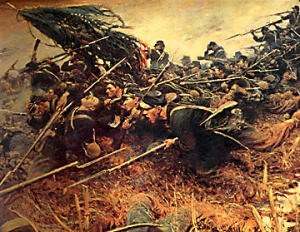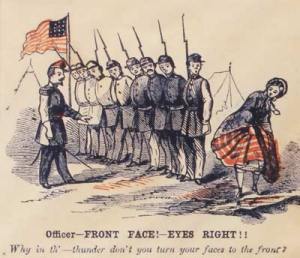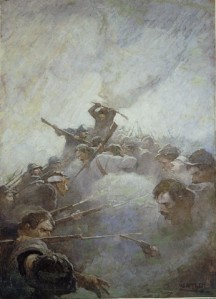
Normally I don’t blog about current events and prefer to focus on subjects directly related to the Civil War, especially the more esoteric or unusual aspects of the Late Unpleasantness. Since there is so much going on in Middle Tennessee regarding the Sesquicentennial, however, I am going to digress a bit this go round. Hopefully I will be able to get back on track with blog entries before the big Battle of Nashville celebrations coming up next week.
While there has been a number of interesting 150th events going on in the Mid South since September, this author has been distracted putting his latest book “to bed,” dealing with Ambrose Bierce and his Civil War experiences (more of that at another time), so I have been very remiss of late. However, this weekend I did have a booth at Mike Kent’s venerable Mid South Civil War Show, now named (I think) the Franklin Civil War Show, ever since the powers that be in Music City decided turning their state fair grounds into a quick profit for developers would be a good idea. That the voters in Nashville did not agree with the politicians and their developer friends has only temporarily delayed them, unfortunately.

Stanley Horn. Next week is the 150th Anniversary of it. Howard Pyle, artist
As an aside, any travelers to Nashville for the anniversary of the battle should be aware that the state fairground itself is smack dab in the middle of battlefield. There is a Confederate “lunette” just down the road on a hill overlooking Nolensville Pike on a small road that leads over a railroad cut and over to Murfreesboro Road. This is the same part of the Nashville battlefield I blogged about in “Captain Aldrich and the Dance of Death” (July, 2014).
In any case, only fifteen minutes south of Nashville by interstate sits Franklin, which, while it too loves its developers and their bulldozers, has done a great deal to not only preserve its historic heritage, but in recent years been highly pro-active in reclaiming parts of the Battle of Franklin battlefield. Yes, you can have prosperity and history side by side and the city of Franklin is proving it–which is one good reason why one of the largest Civil War shows in the South moved down the road to Franklin a few years back.
As usual, Mike Kent’s show had an army of people attending, many in mufti, and there were excellent booths of all descriptions lining both levels of the Williamson County Agricultural Center. In between selling and jabbering about my Ghosts and Haunts of the Civil War and The Paranormal Presidency of Abraham Lincoln books, I talked with a number of nice folks on various topics of the War, (many of which are still in dispute) and learned a thing or three I didn’t know about before. Besides the two main Civil War books, I also had Strange Tales of the Dark and Bloody Ground on sale, as well as Ghosts and Haunts of Tennessee, which also cover a number of Civil War topics and I sold a few of those as well. I also did a bit of jawboning about my upcoming Bierce book and ran into one Civil War enthusiast from Indiana was quite knowledgeable about the Ninth Indiana Infantry regiment. Apropos of Civil War ghosts, several of the visitors to my booth told me about their family’s encounters with the supernatural at Civil War sites, which I will relate in a later blog or two.
When time allowed, I also went to the other booths to take a look see at what they had available. While I did buy one or two items, I wish my budget had been as big as my eyes, as there were quite a few collector’s gems on display there. Of course, by gems I mean uniforms, bayonets, swords, muskets and the like. Military Images magazine, a gold mine of pictorial information about the war, also had a booth there and I got to meet Ron Coddington there. In case you are not familiar with him and his work, he is the go-to expert for Civil War photography, especially cartes de visites and the like, and has written extensively, not only for MI for Civil War News and the New York Times. If ya’ll have never seen Military Images, I recommend it highly.

There were some unusual booths as well. I have blogged about sex and single soldier before and I still have hopes of convincing some publisher to let me do a book just on real romances of the Civil War (yes, folks, grandpa and grandma somehow managed to meet and reproduce, even during the Civil War), but one lady had a booth which was a revelation even to me. It had a wealth of documents, photos and other memorabilia about the distaff side of the Civil War, especially with regard to the armies of “shady ladies” who served their country in way not often written about. All of her displays were interesting and some surprisingly risqué for the 1860’s. Almost all of what her booth on exhibit has never been published before—which goes to show that there is quite a lot still out there about the war all of which have yet to see their way into print.
All in all, the 26th annual show was a success, both for my own books, but for Civil War enthusiasts attending in general. This year in particular the show occurred at an ideal time, bracketing as it does the sesquicentennials of both the Battle of Franklin and the Battle of Nashville. Not to be down on my home town, but compared to little Franklin, one would expect Nashville to have done more over the years regarding its Civil War heritage and preservation. In fairness, there have been some very active people interested in promoting Nashville’s Civil War sites and their preservation; and coming up in mid month there will be a lot going on in Nashville to celebrate the 150th anniversary of the battle one historian called “decisive.” If anyone out there reading this happens to be traveling through the city for the holidays on their way towards other destinations, be sure to take a day or two to linger and take in one or another of the special events happening for the Battle of Nashville anniversary. You’ll be glad you did.




